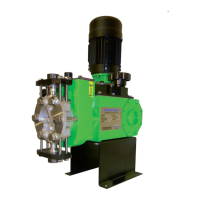11.5.2 Inspection
Remove and inspect the diaphragm assembly. It may have taken a permanent convex/concave
set as a result of normal flexure and conformance to the dish-plate. This condition is normal
and is not cause for replacement. The diaphragm must be replaced if it is deformed, dimpled,
or obviously damaged.
If the diaphragms have been removed from the spacer ring, the entire assembly should
be replaced to ensure proper sealing of its components.
11.5.3 Leak Detection Diaphragm Reinstallation
1. Ensure that the critical sealing areas of diaphragm assembly, reagent head, and pump head
are clean and free from debris. Align the diaphragm assembly capillary tubes with mating
holes in the seal groove in the reagent head and position it in place against the reagent
head. Ensure seating of the diaphragm sealing ring into the mating groove in the reagent
head.
2. Install the reagent head bolts and tighten in an alternating pattern to ensure an even seating
force. Torque to the values recommended in Appendix IV.
3. Apply sealing compound to the gauge/pressure switch assembly and reinstall to the upper
port on the reagent head.
4. Apply sealing compound to the fill valve assembly and reinstall to the lower port on the
reagent head.
5. Open the needle valve
6. Connect a hand-held vacuum pump or other vacuum source to the vacuum port, which fits 6
mm (1/4 in.) I.D. tubing.
7. Re-prime the pump head hydraulic system, see Section 7.2.2 on page 18
8. After diaphragm set-up and priming, the pump is ready to be returned to service.
11.6 Leak Detection system conversion
Some older Pulsar pumps included a Vacuum Leak detection system which is no longer
available. Conversion information to the new Pressure system can be found in Bulletin CV-LD-
0203 (vacuum to pressure system). For further conversion information and kits, please contact
your local Pulsafeeder sales representative.

